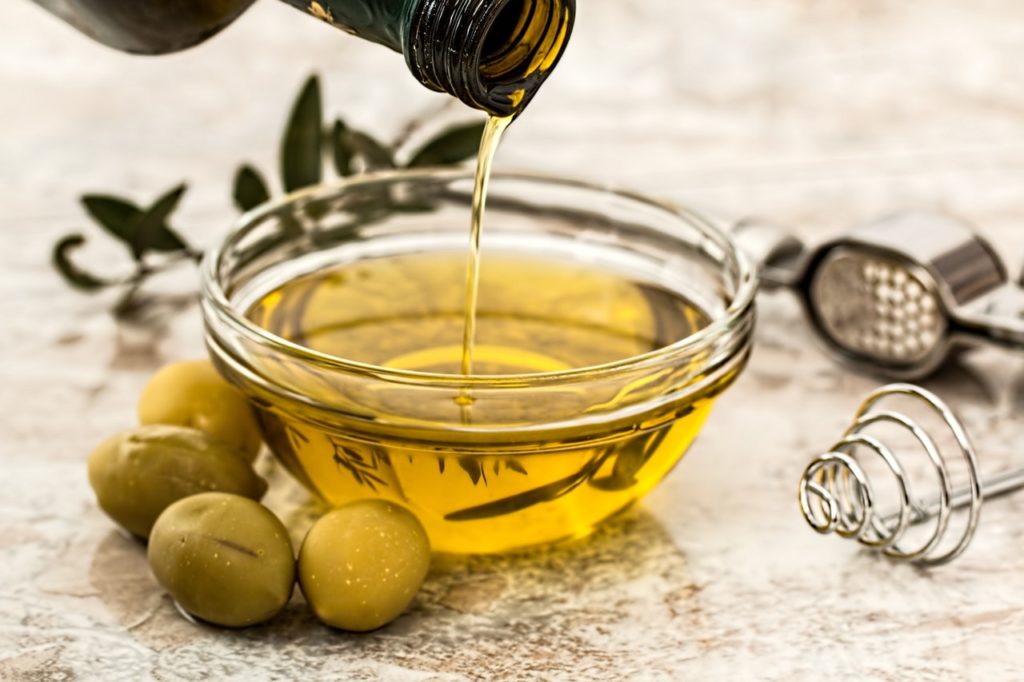
It is olive oil that is made cold-pressed, without heat or chemicals.
Olive oil has been used for thousands of years. Olives grow naturally around the Mediterranean and they were picked and eaten by Neolithic people about 6,000 years ago. Olives appeared in Asia Minor, which is where Turkey is today. The olive tree was probably carried to Persia, Mesopotamia, Syria, Israel, and into North Africa. Many people think that the Egyptians were the first people to start cultivating olives. People first started making oil in about 4,000 BC, but it was used for religious rituals, medicines, fuel in oil lamps, making soap, and skin care.
In 3,000 BC, Crete became the center of olive cultivation and olive oil production. The Greeks used it for a myriad of purposes, and it spread with their empire. Olive farming started in Spain and other parts of the Mediterranean. The oil was made by putting olives in woven mats and squeezing them. The oil was collected in vats. When the Romans took over the Greek Empire, they also took over the production of olive oil. During their empire, the amount of olive oil produced skyrocketed. 750 olive oil production sites across the Roman Empire have been identified by archaeologists. To be able to produce so much olive oil, they had to change the way it was made. The woven mats took too long, so they started using olive presses. Whether or not they actually invented the press is hard to say, but they certainly mastered its use. Some places, such as Tripolitania, which is where Libya is today, produced 30 million liters a year. In 46 BC, Caesar made the people of Tripolitania pay a tax of 1.2 million liters of olive oil.
In a traditional olive press, there is a large millstone that is used to grind the olives and their pits into a pulp. This millstone would be turned by an ox. The pulp was collected up, kneaded, and placed into a woven basket made of rushes or palm fronds. The baskets were stacked on top of each other inside a walled space. A heavy stone was placed on top, which crushed the oil and forced out the oil and the vegetable water. Often the stone weights were hung on a long horizontal beam. The walled space with the baskets would be at the lower point of the beam. The beam would have a press stone attached at that point. Farther along the beam, stone counterweights would be attached, and the principles of leverage would bring a lot of force to bear on the olives. The liquid would flow into a tank and the oil would rise to the top where it could be decanted off. A press like this could make 200 liters of olive oil from one ton of olives.
Once the oil was decanted off, the leftover liquid was not wasted. It is called amurca in Latin and it is a watery, bitter-tasting, smelly liquid. It was used to finish wood, or it was boiled into a grease that could be used on axles or leather. It was used as a fertilizer and an insect repellent. It was eaten by animals and was even used to treat illnesses. However, these days, it is discarded and is a pollutant. It is one of the problems involved with the mass-production of olive oil.
Olive oil was produced by this method for centuries. The invention of the hydraulic press by Joseph Graham in 1795 changed things. These days, the olive oil process is mostly mechanized, but it is still done with a press. The olives are ground with machines and then spread on synthetic fiber discs. These serve the same purpose as the woven baskets, but they last longer and are much easier to clean. The oil is also sometimes separated from the water using a centrifuge instead of simple decanting.
So, what is extra virgin olive oil? After the olives have been pressed and the oil and the amurca have been separated, the oil has to be filtered. If it isn’t filtered, it will be cloudy and have bits of olive flesh and pit in it. The general way to process it is to heat the oil and then use chemicals to bleach and deodorize it. This produces a very clear oil of even quality, but it reduces the amount of omega-3 fatty acids and some other nutrients. This is basic olive oil. Virgin olive oil doesn’t use any heat, but it has a higher acidity level. The oil might have some flaws and not be perfect. Extra virgin olive oil is cold-pressed and is the first oil that comes off the olives. It uses the highest quality olives and has a lower acidity. The fruit is filtered out, but it tastes very strongly of olives. It has no flaws. The process leaves more nutrients in the oil and gives it more flavor and aroma. It has more flavor than virgin olive oil and is more expensive as there is less of it. Extra virgin olive oil is recommended for eating as is because it loses quality and flavor when it is heated.
Sources
https://brightland.co/blogs/field-notes/olive-oil-origins
https://www.thoughtco.com/ancient-history-of-making-olive-oil-4047748
https://en.wikipedia.org/wiki/Olive_oil
